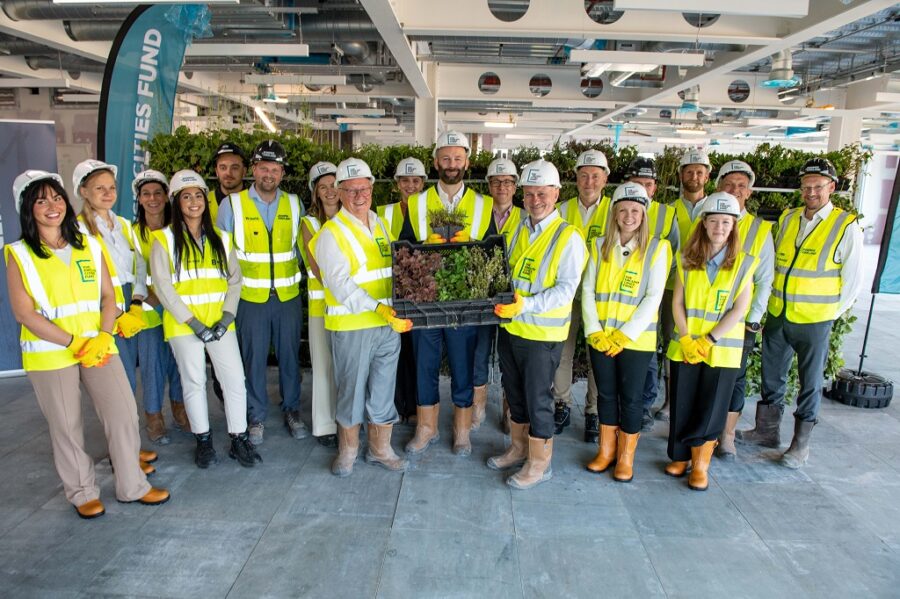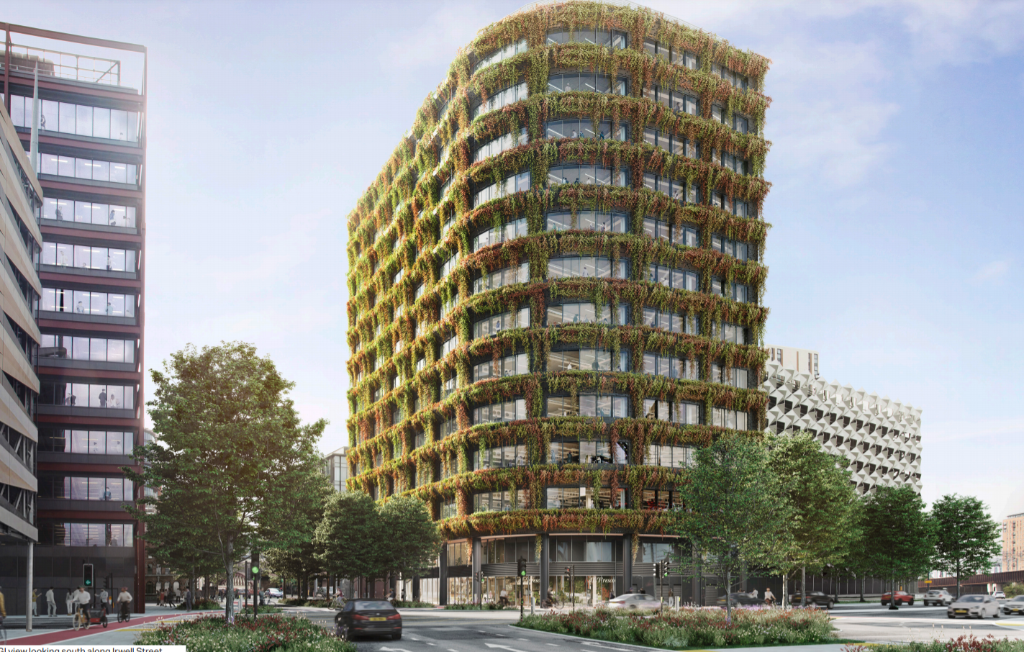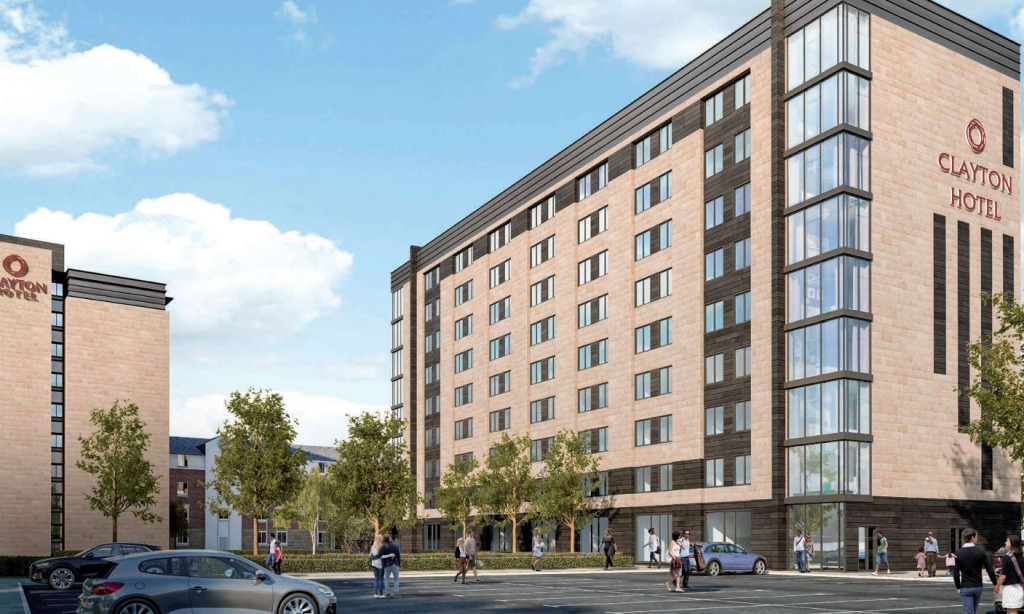Eden’s epic living wall is nearly complete – but how will it work?
When it opens later this year, developer English Cities Fund’s latest office building in Salford will turn heads with its 43,000 sq ft green façade.
Eden’s 350,000-plant living wall will be the largest of its kind in Europe, according to ECF. The wall is fast nearing its July completion date, with ECF chair Sir Michael Lyons and Salford City Mayor Paul Dennett attending a ceremonial “planting out” to commemorate the occasion on Wednesday.
“Eden has already become an icon for our city; an embodiment of creative strength and statement of positivity in a city with a proud heritage of innovation,” Dennett said at the time.
“More than that though, it symbolises everything we need to embrace going forward in terms of community and sustainability. We all need to do our bit to look after each other and the world around us.”
Resisting claims of greenwashing, ECF has touted the wall’s biodiversity, carbon storage, and insulation credentials. So how will this living wall work in practice – and how did it come about?
Place North West spoke with Eden’s living wall expert ANS Global and developer Muse, one of the three companies that make up ECF alongside Legal & General and Homes England, to find out more.

ECF chairman Sir Michael Lyons, Salford City Mayor Paul Dennett, and TLT partner Graeme Orchison were among those who attended the planting out ceremony. Credit: via RMS
The Eden dream
The £36m Eden, situated off Stanley Street in New Bailey, has been ambitious from the start.
“This place-changing building has been designed to push the envelope in terms of sustainable regeneration and highlight what can be achieved when like-minded partners work together to deliver something truly special for the benefit of everyone,” said Ella Woodward, development manager at ECF.
The office block is on track for a BREEAM Outstanding rating and a WiredScore of Platinum. ECF is also gunning for the project to secure a coveted NABERS score of 5.5 stars.
When it comes to wall, boosting biodiversity is one of the wall’s main jobs, according to Phil Marsden, a director at Muse who led the conception of Eden.
Accordingly, the living wall is more than just plants, it also contains bird boxes and bug hotels.
Marsden worked closely with Make Architects to craft the perfect design for Eden.
“When we were considering materials for the facade, the idea of cladding the materials in plants was discussed between myself and the architect,” Marsden said.
“When we looked at the research around the benefits of living walls, we were impressed with the benefits to air quality, reduction in urban temperatures, attenuation of water, noise reduction and improvements to the thermal mass of the building,” he continued.
“What better way to clad a building like Eden. Rather than using brick, stone or concrete, we could use plants grown in this country,” Marsden said.
Plant science
Each of the 32 species of plants on Eden was chosen to fulfill a specific purpose.
“Many years ago, a plant was a plant,” said Niall McEvoy, green infrastructure consultant at ANS Global. “All plants clean the air. All plants do this. All plants do whatever – but they don’t.
“Some plants are wonderful at creating biodiverse habitats,” McEvoy said. “Other plants are brilliant at absorbing carbon and producing oxygen. Other plants are phenomenal at trapping particulate matter.”
At Eden, biodiversity was one of the project’s main focuses. Many of the plants were selected for their ability to provide pollen for bees, nectar for birds, and habitats for insects. If all goes to plan, this will see a biodiversity net gain of 174%, according to ECF.
Plants chosen for biodiversity include cowslip, wild strawberries, St John’s Wort, and bluebells.
Others were chosen for their ability to sequester pollution, a task plants perform naturally through photosynthesis – a process that sees them absorb carbon dioxide and release oxygen. Certain species of plants are particularly adept at absorbing and breaking down pollutants. At Eden, plants such as box, Sutherlandii, and snow-white wood-rush are being used for these purposes.
In the early days of living walls, the theory was that a plant would require less maintenance if its root system was restricted.
“That was proven to be wildly inaccurate,” McEvoy said. So the living walls of today, like the one found at Eden, opt for a different approach. Giving plants more room to grow strong root systems, which will enable them to be more resilient.
As for growing the plants themselves, it’s nothing new.
“A living wall is a method to allow plants to grow, like a flower pot is a method to allow plants to grow,” McEvoy said.
Maintenance
Some may argue that the energy costs behind maintaining a living wall the size of Edens’ negates the benefits. While McEvoy strongly disagreed, he did concede that there is no getting around the fact that maintaining a living wall – like maintaining a garden – requires effort.
Irrigation is the only part of the wall that requires power, McEvoy said. Eden’s system will run once a day on average for around five minutes per each of the wall’s 48 irrigation zones. On the hottest days, the system may run twice, while in the winter it may only run once every two or three days, according to ANS.
At Eden, most of the water for the plants will come from rainwater harvested on the roof. The irrigation system will also be backed by the mains in case there is a particularly dry spell.
Innovations in technology also allow for remote checks on the irrigation system to see if it is operational and running smoothly by enabling those monitoring to spot problems as they occur.
ANS will also do monthly visual health checks to make tweaks to the irrigation system, and then prune the wall back once a year. McEvoy estimates that pruning the wall could take more than two weeks given the façade’s size.
While he admits there is an energy cost, McEvoy contends it is worth it.
“There aren’t many items that we produce that give us as many benefits as green infrastructure,” he said.
Beyond the wall
The living wall aside, ECF has been ambitious with its vision for Eden. The 115,000 sq ft office block is to be powered completely by renewable energy – part of which will be generated on-site with solar panels.
Eden is meant to be operationally net zero when it comes to carbon emissions. Accordingly, the space will use air-source heat pumps to provide both heating, cooling, and hot water. Fittings have been installed that are geared towards low water usage and have leak detection technology. There are ventilation technologies that will help bring more fresh air into the offices.
Even the lifts will get in on the action, boasting regenerative tech that allows them to feed energy back into Eden’s power grid when the elevators are in operation.
The living wall, in ECF’s Woodward’s words, is just “the icing on the cake of the building”. It catches people’s attention and creates excitement – but it is not the entirety of the dessert.
“The building is so well designed,” McEvoy added. “It brings in all these elements around sustainability, however, you can’t see all of those items.
“You can’t see how well it has been insulated,” he continued. “You can’t see the CO2 sensors cleaning the area. But what you can see is the largest living wall in Europe…
“You take away the living wall and that building is still the model other buildings should adhere to. The living wall just highlights it.”
What’s next?
Main contractor Bowmer + Kirkland is on track to complete work on Eden in September.
Paul Sykes, regional director at Bowmer + Kirkland, noted that it had been a busy few weeks for Eden, adding that “we are now watching the building come to life”.
He added later: “It’s not very often that we get to build something that will continue to grow in front of our eyes and provide a home not only for the people working in the building but also a habitat for a diverse range of creatures.”
Law firm TLT is already signed on to take the top two floors of the 12-storey Eden, having signed a 15-year lease for 20,000 sq ft in January.
“Our Manchester team is very much looking forward to its move to Eden – a move which cements our commitment to the region whilst also representing our commitment to sustainability, and a people-first culture where employees have the space and support to produce their best work,” said TLT partner Graeme Orchison.
“Our values are very much reflected in Eden’s ground-breaking approach that will lead the way for the future workplaces that are both better for our people and the planet.”





Love this development wish more buildings could be covered like it
By Bob
They need to convert a lot of the existing dates buildings in the city centre if this is successful.
Would definitely help bring some greenery into a city which desperately needs it.
By Anonymous
Watched an interesting documentary by the B1M I think on YouTube about living Walls and Green buildings. It seems to be a rather more challenging thing to do than one would suspect which is why we don’t see them all over the place. Well done to all concerned for this one.
By Tom
Absolutely brilliant work – well done to everyone involved. Lots more of all of this please 🙂
By Mancunian
What about damp and mold on the walls inside of the building will this not effect the buildings structure the same goes for the roots system sticking to the building just like ivy if it’s allowed to grow out of control
By Frances
Amazing n beautiful work
By Yonas Meshesha
Come back to me once they’ve worked out the maintenance and watering bill from Year 1.
And let’s stop pretending covering a building with a load of plants of itself makes for a good building.
By Anonymous